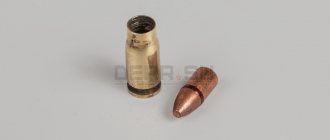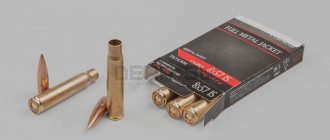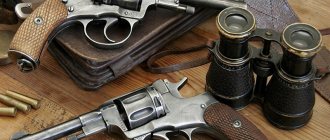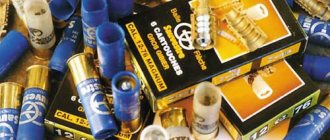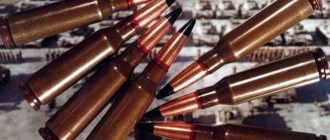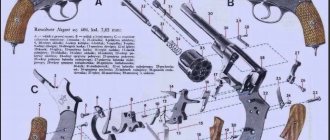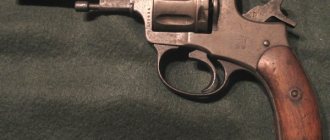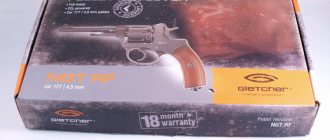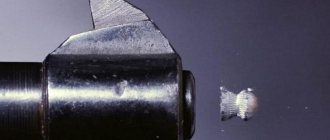Nagana arr. 1895
Published by admin on Sun, 06/20/2010 – 19:43
Revolver Nagan arr. 1895
Tactical and technical characteristics of Nagan arr. 1895: Caliber, mm – 7.62x38R (7.62 Nagant) Total length, mm – 235 Barrel length, mm – 110 Weight with drum without cartridges, g – 795 Weight with loaded drum, g – 880 Drum capacity – 7 Combat rate of fire – 7 shots at 15-20 s
The famous 7.62-mm Nagan revolver, adopted by the Russian army in 1895, was developed in Belgium and has a long history of its appearance. The Belgians Nagant brothers (Emile and Henri-Leon Nagant) began developing revolvers back in the 1880s, and by 1894 they had received patents for a revolver with powder gas obturation. In 1895, the revolver of the Nagan brothers system was adopted for service in Tsarist Russia, and - in two versions - for officers and police, a conventional revolver with a double-action trigger was provided (allowing shooting and self-cocking, that is, by pressing the trigger without first cocking the hammer .), and for the lower ranks the revolvers had a simplified single-action trigger (in which you need to cock the hammer manually before each shot).
The first deliveries of revolvers to Russia were from Belgium, but from about 1898 the production of revolvers mod. 1895 was established in Russia, in Tula at the Tula Arms Plant (TOZ). It is believed that a number of revolvers made in Russia were supplied to the Romanian army, but most likely this was an experimental batch intended for testing and testing.
With our help, you can assemble a cartridge for a Nagant with your own hands!
It should be noted that the kit offered in our assortment in the form of a primed cartridge case and a bullet is not intended for the manufacture of real cartridges - this is illegal due to Article 223 of the Criminal Code of the Russian Federation. However, with our help, you can assemble a training cartridge for the Nagan with your own hands - the legislation of the Russian Federation does not prohibit the use of ammunition components for assembling training manuals and mock-ups.
Cartridge 7.62 Nagant
Published by admin on Wed, 05/06/2009 – 23:58
7.62 mm Nagant cartridge
Performance characteristics of the 7.62 mm Nagant standard cartridge
Caliber, mm – 7.62 Initial bullet speed, m/s – 279 Muzzle energy of the bullet, J – 210 Cartridge length, mm – 38.7 Cartridge weight, g – 11.6-12.8 Bullet weight, g – 6, 7-7 Weight of powder charge, g – 0.3
The standard 7.62 mm cartridge was developed by Leon Nagant for a revolver of his design in 1887. The 7.62 mm Nagant cartridge is intended for firing from a revolver of the 1895 model and its modifications.
A distinctive feature of the cartridge from other revolver cartridges is the placement of the bullet in the cartridge case.
7.62x38 Nagant (7.62x38R Nagant)
In 1892, Leon Nagan presented a seven-shot revolver and 7.62 mm caliber cartridges of his own design to the Arms Department and Artillery Committee of Russia for testing. The first cartridges had a brass sleeve with a welt, were equipped with a Berdan system capsule and a bullet weighing 6-7 grams with a lead core and cupronickel shell. The cartridges were loaded with both black hunting powder and experimental smokeless powder developed by the Okhtensky Powder Plant. For testing in 1895, a version of the cartridge with a charge weighing 1.1 grams of black powder was recommended (since the experimental smokeless powder of domestic production did not yet meet the requirements for it) and a modernized bullet with a flat tip. The cartridge bullet had an initial flight speed of 265-285 m/s. This change in the design of the bullet made it possible to increase the gap from the edge of the cartridge case to the tip of the bullet and ensure free movement of the revolver drum when the bullets in the cartridge shifted under the influence of inertial loads during shooting. Also, the flat tip of the bullet provided increased stopping power.
On May 13, 1895, the Nagan system revolver and a 7.62 mm revolver cartridge were adopted into service with the Russian army. The production of revolver cartridges was established at the Tula Cartridge Plant. Somewhat later, in order to improve the fastening, the bullet began to be additionally fixed with fastening by punching the cartridge case in increments of 180°. Over the entire production period, the design of the cartridge has undergone minor changes. After the 1917 revolution, revolvers and cartridges for them remained in service with the Red Army. At the end of World War II, revolver cartridges began to be loaded with P-45 smokeless pistol powder. In the mid-30s, a cartridge with a surrogate bullet with a steel core and a cartridge with a bimetallic sleeve were developed, but due to production difficulties, cartridges with a surrogate bullet were produced for a short time.
The cartridge with the P bullet is designed to defeat manpower at ranges of up to 50 meters. The cartridge was equipped with a bullet with a lead core. In the 30s, during modernization, the cupronickel bullet casing was replaced with a bimetallic one. At the end of the 80s of the last century, cartridges began to be equipped with a bullet with a steel core from a 7.62 mm pistol cartridge of the 1930 model. In the mid-30s, cartridges with a surrogate bullet with a steel core and cartridges with a bimetallic sleeve and brass-plated steel sleeves were produced for a short time. In the 30s, for a short time, cartridges were produced for Tokarev and Korovin submachine guns, which differed from revolver cartridges by rolling the leading edge of the cartridge case in order to eliminate misfires when feeding cartridges from the magazine. In the 70s, the production of revolver cartridges with a reduced charge was launched, which were used for shooting from worn-out revolvers in service with the Ministry of Internal Affairs units and for practical shooting. Such cartridges differed only in the additional inscription on the packaging “REDUCED CHARGE”. The cartridges were packed in paper packs of 10 pieces, and later in cardboard boxes of 14 pieces. The cartridges had the symbol “7.62 R gl”.
In the early 30s of the last century in the USSR, by order of the GAU, work began on the creation of devices for silent shooting (SBS), which were planned to equip army reconnaissance and sabotage groups. Work on the creation of PBS was launched at the NIPSMVO in Shchurovo and at the Scientific and Technical Committee of the State Agrarian University (Scientific and Technical Committee of the State Agrarian University). By 1940, samples of PBS developed by the brothers I.G. were provided for testing. and V.G. Mitin, designed for shooting from a rifle, carbine and revolver of the 1895 model. The Bramit device is designed according to a two-chamber design with cutoff of powder gases using rubber seals. In the expansion chambers, hot powder gases slowed down and cooled, flowing out of the device at a much lower speed, which reduced the sound of the shot and eliminated the flash of the shot. Tests have shown that when firing standard revolver cartridges with a bullet with a blunt tip, the accuracy of fire drops significantly due to the collision of the bullet with the rubber seals. To solve this problem, a special cartridge was developed with a pointed bullet with a lead core. The accuracy of fire with the Bramit device at a distance of 20 meters was: Vv - 9.3 cm and Vb - 7.5 cm, and when firing standard cartridges without PBS, these figures were 1.84 cm and 1.7 cm. Nagan cartridge bullet -Bramite also had a weak penetration effect - two inch pine boards with a gap of 75 mm at 20 meters.
In addition to the main combat cartridge, blank and training cartridges, a special cartridge for silent shooting and a version of the cartridge for the Tokarev submachine gun were developed. In the 30s, the revolver bullet was modernized - the nickel silver shell was replaced with a bimetallic one. At the end of the 80s, cartridges began to be loaded with bullets from a 7.62x25 TT pistol cartridge. Until 1918, revolver cartridge cases did not have bottom markings. Since 1918, cartridge cases were marked with the letters “TPZ” (Tula Cartridge Plant) indicating the year of manufacture. Since 1932, the cartridges were marked with the letter “T” indicating the year of manufacture, and since 1938, the letter designation of the plant was replaced by the number “38”. In 1941, the plant was evacuated from Tula to the city of Yuryuzan, where the production of cartridges continued until 1989.
Based on the revolver cartridge, hunting cartridges of 5.6 mm, 6.5 mm and 7.62 mm caliber, a sports cartridge V-1 and a sports cartridge with a shortened sleeve 4ELP-1000 were developed. The production of cartridges for the Russian revolver was carried out in Great Britain, Poland, Germany, Romania, France, Italy and others.
In 1953, the USSR launched production of the TOZ-36 sports revolver, for which the V-1 sports cartridge was developed on the basis of an army cartridge. The cartridge was filled with a cylindrical, shellless lead bullet with a conical recess in the bottom (which ensured better sealing of the powder gases in the barrel). Thanks to this design, the bullet has 3-3.5 better accuracy compared to a cartridge with a jacketed bullet. The cartridge had the symbol “7.62 SR GL” on the packaging and was accepted for supply to the troops under the GAU symbol 57-N-111.
The training cartridge is intended for teaching the rules and techniques of handling weapons and ammunition. The training cartridge consists of the components of a live cartridge, but does not contain a powder charge, the primer is cooled. The cartridges were filled with a P bullet or either a bullet jacket. It was allowed to use a 7.62-mm caliber pistol cartridge for training cartridges. 1930 The first training cartridges were made using a brass case filled with epoxy resin. Four vertical and two horizontal knurls were made on the sleeve, painted with red paint (in the manner of English training cartridges). The training cartridge cases were chemically blackened. In the 30-40s, training cartridges were marked with transverse annular knurls on the cartridge case (two, three or four, depending on the condition of the equipment). In the post-war years, TsNIITOCHMASH specialists developed the 7X7 training cartridge, which has a distinctive marking in the form of 4 longitudinal knurls on the sleeve.
In 1957, at the XXV Moscow Regional Anniversary Exhibition of Hunting and Hunting Dog Breeding, a 7.62-mm hunting cartridge developed by M.N. Blum was presented. The cartridge was created on the basis of the brass cartridge case of the Nagan system revolver and was intended for firing from samples of hunting combined weapons and lightweight carbines. The cartridge is intended for shooting at small and medium-sized animals, as well as large waterfowl and upland birds (goose, wood grouse, black grouse, etc.). The cartridge was loaded with a jacketed bullet with a lead core. Cartridges of a similar design were also produced in the 30s (known examples have cartridges manufactured in 1932) with bullets from pistol cartridges. During the war years, these cartridges were sometimes converted into revolver cartridges by seating the bullet under the cut of the cartridge case. The cartridges produced in the 1930s differed from the post-war cartridges in their distinct bottle shape.
Nagant Mle.1910
Published by admin on Sat, 02/14/2009 – 18:10
Nagant M1910 revolver
Tactical and technical characteristics of Nagant M1910: Caliber, mm – 7.62 Nagant (7.62x38R) Length, mm – 235 Barrel length, mm 110 Weight without cartridges, g – 795 Drum, no. cartridges – 7 Sighting range, m – 50
Since 1892, the Belgian company Fabrique d'Armes Léon Nagant (Fabrique d'Armes E. and L. Nagant) of the brothers Emile and Leon Nagant has been taking part in a competition held by the Russian government for a modern model of short-barreled personal weapons. Based on the results of this competition, the Nagant M1895 revolver was adopted into service with the Russian army in 1895, which became the most successful model of all the revolvers of the Nagan brothers, largely thanks to the powder gas obturation system.
Then, in 1895, the Russian government entered into a contract with the Nagan company to supply the Russian army with 20,000 of these revolvers over the next three years. After fulfilling the terms of the contract, production in Belgium was completely stopped and established in Russia (where, until the mid-twentieth century, over 2 million Nagan revolvers of the 1895 model were produced). nagan-m1895
Design of the 1895 Nagant revolver
The 1895 Nagant pistol was based on the 1892 model. But adapting the weapon to the requirements of the Russian army, it was equipped with a drum for seven rounds of 7.62 x 38 mm caliber, traditionally produced in two versions - “officer” with a self-cocking combat mechanism and “soldier”, requiring manual cocking of the hammer.
One of the design features of the weapon is the reloading method. To reload, it was not necessary to remove the drum; for this reason, it was on a spring-loaded axis, and for loading it was necessary to fold back the lid covering the chambers of the drum, which greatly slowed down the reloading process.
To remove the spent cartridges, the lid was also folded back, the cleaning rod was moved to the side, and by inserting it into the cavity of the cartridge case, extraction took place. But this innovation was also a plus - in non-standard situations, cartridges did not fall out of the drum, as, for example, happened in the Gasser revolver of 1870.
One of the key features of the weapon was the solution to the problem of breakthrough of powder gases, which reduced the power of the shot. To do this, they used a cartridge with a bullet recessed into a fairly long sleeve and changed the drum drive, which allowed it to move along its axis. Thus, during the firing process, the drum moved in the direction of the shot, and the sleeve protruding slightly beyond its limits entered the breech of the barrel. By expanding, the cartridge case blocked possible leaks of powder gases, and after the bullet left the barrel, the drum moved back along the axis, simultaneously bringing a new cartridge under the barrel. This principle was called “obturation,” created by the Nagan brothers’ closest competitor, Henri Piper, designer of the Bayard systems.
How the revolver works
The operating principle and design of the weapon does not differ significantly from the rest of its contemporaries, except for the obturation process. To fire a shot, the shooter pulls the trigger, uncocking the hammer. As the trigger moves, the drum moves along its axis and forward, driving the cartridge case into the breech of the barrel. The trigger hits the cartridge primer, igniting the powder mixture, and a shot occurs. The drum then moves back. The next shot repeats the process.
In the “soldier” version, it was necessary to manually cock the weapon before each shot.
Revolver “Nagant” interactive model
Revolver trigger
The trigger mechanism is a classic hammer type. The firing pin is attached to the trigger with a hinged mount. The combat plate is located in the handle. The sear and trigger are combined into one part. There is no safety cock; its role is played by a special part that blocks the interaction of the firing pin and the cartridge without pressing the trigger. When the trigger was pressed, the part was moved to the side, allowing the striker to puncture the capsule.
Cartridge for a revolver
The Nagan revolver cartridge 7.62 x 38 was specially designed for the 1895 model. The ammunition had a narrowed neck of the cartridge case, necessary for sealing in the barrel bore. It was thanks to this design that it became possible to create the BraMit modification.
Ballistic properties
The bullet demonstrated good accuracy for those times - at a distance of 25 meters, about half of the ammunition was placed in a circle with a diameter of 13 centimeters. If the shooter used a stop, then the diameter of the circle was reduced to 7 centimeters.
The penetrating ability of the bullet was also impressive - at a distance of 25 meters it pierced through three boards two and a half centimeters thick, standing at a distance of 8-10 centimeters from each other.
Operation and combat use
The 1895 Nagant revolver went through a long battle path, ending it in the mid-2000s: the suppression of the Yihetuan uprising, the Russo-Japanese War, two world wars, the October Revolution and the Civil War - this is not a complete list of armed conflicts where the revolver was used in combat. In the mid-nineties, they remained in service only with geological expeditions, but even from there they were withdrawn as an obsolete weapon.
Use in Russia and USSR
The Nagan revolver became the standard weapon of officers of the army of the Russian Empire in 1895. But due to the constant reduction of the military budget, it was possible to equip the army with the necessary amount of weapons only in the second half of 1917.
How the revolver appeared in the Russian army in 1895
At the end of the 19th century, the question of rearmament of soldiers and officers of the Russian army was raised. The officers' personal small arms were Smith & Wesson III 1880 revolvers. The heaviness and inconvenient dimensions, unsatisfactory technical characteristics only hindered its use.
To select the optimal model, the Ministry of War decided to hold a competition for the development of personal weapons. There were only two competitors - the brothers Nagan and Henri Pieper with the Bayard 1889 model. For unknown reasons, the results of the first competition were canceled.
The second competition took place some time later, as a result of which the Nagan brothers won, providing a weapon that fully met the performance characteristics of the commission’s requirements. According to the rules of the competition, the winner had to renounce the right of monopoly production, ensure the transfer of drawings and set up the production of weapons in Russia, and also had obligations to supply the first batch of weapons.
The opinion of the officers who participated in the tests was also important. It was thanks to the opinion of these officers that the decision was made to divide the weapon into an officer's revolver and a soldier's revolver, the difference between which lay in the design of the trigger. The unanimous opinion was that junior ranks of the army should not be trusted with a self-cocking weapon model due to the low level of shooting training, and the model with a double-action trigger was slightly inferior in accuracy due to the heavy trigger, and, accordingly, a sharp jerk when firing.
1900-1917
From the moment it was put into service until the 1917 revolution, the revolver managed to establish itself as an unpretentious and reliable weapon, having passed through several major military conflicts with honor. Also, in 1915, the modernization was finally rejected, which actually turned the revolver into a carbine with a barrel length of 300 mm.
1917-1939
Having become a model of weapon reliability, Nagan continued to serve in the Red Army, but only in the self-cocking version. The only modernization during this period was carried out in 1930, slightly changing the shape of the sighting devices. Around the same years, the tradition took root of considering all revolvers to be the “Nagan” system, which is fundamentally incorrect.
1939-1945
For a number of reasons, weapon production was not stopped after the adoption of the TT semi-automatic pistol. One of them was the possibility of firing from personal weapons through the embrasures of a tank, for which TTs were not suitable, and new weapon models did not pass factory tests.
The process of evacuation of the Tula arms factory to Izhevsk greatly affected the quality of weapons. Most of the qualified specialists were called up to the front in the ranks of the active army. The process of outflow showed itself to be especially strong in the case of Nagan revolvers produced in 1942, when a fairly large percentage of defects was revealed during the production of weapons.
However, in 1945, the production of revolvers was discontinued due to obsolescence. At the same time, the Nagant was finally removed from the army's arsenal. But he remained in service in the ranks of law enforcement agencies and the justice system.
Main modifications of Nagant
Nagant 1910 - a modified model, had a drum that tilted to the right to increase reload speed.
Combat
- The Soldier's Nagan is a revolver with a single-type trigger. Out of production in 1918.
- The Commander Nagan is a revolver with a self-cocking trigger; for concealed carry, the barrel was shortened and the handle was reduced. Mainly used by NKVD officers.
- version for sabotage operations, modified by the Mitin brothers. The process of pressing the cartridge case into the breech of the barrel has been improved; it is possible to mount a silent combat device designed by the Mitins. Also for this modification, cartridges with a pointed bullet were developed.
Civil
The emasculated Nagan (abbreviated as SHP), as well as its MMGs, converted from combat copies, but deprived of the ability to fire a shot, are very popular among collectors and weapon lovers. Also, due to its legend, the empty Nagan revolver is often found in films, TV series, etc.
Sports
Based on the Nagan, the following variants of sporting weapons were developed:
- A revolver designed by Smirny in 1926 chambered for a 5.6 mm rimfire cartridge.
- The 1953 Nagant revolver had a weighted barrel and an adjustable sight. Single action trigger
- MTs-4 designed by Paramonov.
- TOZ-36 is a sports revolver designed by Khaidurov.
- TOZ-49 - modernization of Khaidurov’s revolver chambered for 7.62 x 26 mm.
- TOZ-96 is a model chambered for .32 S&W Long Wandcutter.
Sporting and hunting weapons
- KR-22 “Falcon” is a conversion model with a 500 mm long barrel, designed for hunting small animals. Caliber .22LR.
- The Gnome is a sports training pistol chambered for the 4 mm Flaubert cartridge.
Civilian self-defense weapon
Gas and traumatic versions of weapons are produced on the basis of decommissioned combat revolvers:
- Traumatic revolver R-1 “Naganych” chambered for 9 mm RA cartridge;
- Traumatic revolver Nagan VPO-502 and service RS for caliber 10 x 23T;
- Skat-1R;
- Brigade commander;
- Nagan RF;
- RNR UOS;
- Skat-1Rk is sometimes called shortened Nagan;
Also in Ukraine, the production of G-Nagan has been established - a classic version, converted into a gas revolver for self-defense.
